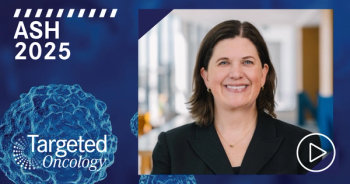
Allogeneic Transplantation and GVHD Prophylaxis
An expert on graft-vs-host disease discusses allogeneic stem cell transplantation, and reviews transplant conditioning and GVHD prophylaxis regimens.
Case: A 35-Year-Old Woman with Chronic GVHD
- A 35-year-old woman received busulfan and cyclophosphamide conditioning prior to a matched unrelated donor peripheral blood stem cell transplant for acute myeloid leukemia; tacrolimus and methotrexate were administered as graft-vs-host disease prophylaxis.
- PMH of type 2 diabetes.
- Post-transplant, experienced the following:
- +1 month post-transplant, grade II acute skin GVHD, resolved with glucocorticoids
- +6 months post-transplant, grade I vaginal dryness, treated with topical estrogen
- +11 months post-transplant, grade I dry eyes/foreign body sensation, treated with lubricating eye drops
- Now, + 12 months post-transplant, grade 2 muscle and joint paint that limits daily exercise routine, treated with prednisone
- Supportive care and counseling provided
- 1 mg/kg/day prednisone tapered to 0.25 mg/kg/day
- During steroid taper, patient developed grade 2 mouth symptoms with ulceration and lichenoid features as well as maculopapular rash/erythema on lower torso (BSA 10%)
Transcript:
Nelson J. Chao, MD: This patient received an allotransplant for AML [acute myeloid leukemia] using peripheral blood from an unrelated donor. Allogeneic transplants are commonly used for different leukemias, like AML, ALL [acute lymphoblastic leukemia], CML [chronic myeloid leukemia]; lymphomas; myelodysplastic syndrome; and myelofibrosis. This probably encompasses most of the group of patients who received transplant. The source of donor cells could be a bone marrow, peripheral blood, or an umbilical cord. The conditioning regimens will vary depending on whether the patients are young and fit or old and frail. The donor bone marrow source varies depending on the ability to find a good match.
Besides using bone marrow or peripheral blood, the change has been our ability to use haploidentical transplants or half-match transplants from a family member—a parent for a child or a child for a parent, where the HLA matching is just the haplotype. That has increased our ability to use allogeneic transplant for these patients, where in the past finding donors may have been difficult. As part of the whole package, the conditioning regimen is very important. We would like to use ablative conditioning for everybody because that allows for the highest potential to control the underlying disease. Unfortunately, the older, frailer patients wouldn’t tolerate that. In older patients who have more comorbidities, we tend to use a reduced intensity, where the conditioning-regimen intensity is decreased.
In younger patients, the conditioning regimens that tend to be used are busulfan for 4 days with cyclophosphamide or fludarabine, or total-body radiation with cyclophosphamide or fludarabine. Total-body radiation at 1200 or 1350 cGy. But for older, frailer patients, the busulfan dose is cut in half to 2 days rather than 4 days. We tend not to use total-body radiation in frail patients because they don’t tolerate that very well. More recently, adding thiotepa to the regimen has increased the potential for more robust engraftment. Thiotepa is used for 3 days in the more ablative regimen or 2 days in the reduced-intensity regimen.
GVHD [graft-vs-host disease] prophylaxis is centered on a calcineurin inhibitor—tacrolimus or cyclosporine—in conjunction with methotrexate. That’s been around since the 1980s and has been a backbone for GVHD prophylaxis. What’s changed in the last 5 to 7 years is the introduction of post-transplant cyclophosphamide developed by the group at [Johns] Hopkins [University]. Cyclophosphamide is given on day 3 or 4 following the transplant, in conjunction with the calcineurin inhibitor and mycophenolate. That has resulted in a significant decrease in acute and chronic graft-vs-host disease. Cyclosporine or tacrolimus with methotrexate is still a standard, although that’s rapidly being replaced by the use of this post-transplant cyclophosphamide.
Transcript edited for clarity.









































